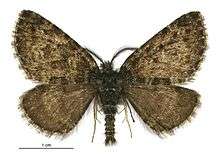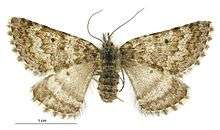Aponotoreas orphnaea
| Aponotoreas orphnaea | |
|---|---|
 | |
| Male specimen | |
 | |
| Female specimen | |
| Scientific classification | |
| Kingdom: | Animalia |
| Phylum: | Arthropoda |
| Class: | Insecta |
| Order: | Lepidoptera |
| Family: | Geometridae |
| Genus: | Aponotoreas |
| Species: | A. orphnaea |
| Binomial name | |
| Aponotoreas orphnaea (Meyrick, 1883)[1] | |
| Synonyms | |
| |
Aponotoreas orphnaea is a moth of the family Geometridae.[2] It is endemic to New Zealand.[3]
Taxonomy
This species was first described by Edward Meyrick in 1883 as Pasithea orphnaea.[4] Meyrick collected the type specimen of A. orphnaea in January of that year near the summit of Ben Lomond at 1700 metres.[4] This moth subsequently became known as Notoreas orphnaea after Meyrick renamed the genus Pasithea as Notoreas when he became aware of that Pasithea was preoccupied.[5] In 1986 R. C. Craw described the new genus Aponotoreas and included A. orphnaea within it.[3]
Distribution and habitat
A. orphnaea has been observed in the high alpine zone of Central Otago in wetland habitat.[6][7] A. orphnaea has also been found in alpine grassland habitat.[8] It is regarded as being locally common on land covered by Mount Aspiring Station.[9]
References
- ↑ "Aponotoreas orphnaea (Meyrick, 1883)". www.nzor.org.nz. Landcare Research New Zealand Ltd. Retrieved 6 February 2017.
- ↑ Dugdale, J. S. (1988). "Lepidoptera - annotated catalogue, and keys to family-group taxa" (PDF). Fauna of New Zealand. 14: 170–171. ISSN 0111-5383. Retrieved 6 February 2017.
- 1 2 Craw, R. C. (1986-01-01). "Review of the genus Notoreas (sensu auctorum) (Lepidoptera: Geometridae: Larentiinae)". New Zealand Journal of Zoology. 13 (1): 131–140. ISSN 0301-4223. doi:10.1080/03014223.1986.10422654.
- 1 2 Meyrick, Edward (1883). "A monograph of New Zealand Geometrina". Transactions and proceedings of the New Zealand Institute. 16: 49–113 – via Biodiversity Heritage Library.
- ↑ Meyrick, Edward (1885). "Notes on the Nomenclature of New Zealand Geometrina". Transactions and proceedings of the New Zealand Institute. 18: 184 – via Biodiversity Heritage Library.
- ↑ "Obelisk Station Crown Pastural Land Tenure Review: Conservation Resources Report - Part 4". www.linz.govt.nz/. Land Information New Zealand. December 2010. p. 10. Retrieved 7 February 2017.
- ↑ Patrick, B. H.; Barratt, B. I. P.; Ward, J. B.; McLellan, I. D. (1993). "Insects of the Waipori Ecological District" (PDF). Otago Conservancy Miscellaneous Series. 16: 33. ISBN 0478014813. ISSN 0114-7455.
- ↑ Mark, A. F.; Dickinson, K. J. M.; Patrick, B. H.; Barratt, B. I. P.; Loh, G.; McSweeney, G. D.; Meurk, C. D.; Timmins, S. M.; Simpson, N. C. (1989-12-01). "An ecological survey of the central part of the Eyre Ecological District, northern Southland, New Zealand". Journal of the Royal Society of New Zealand. 19 (4): 349–384. ISSN 0303-6758. doi:10.1080/03036758.1989.10421841.
- ↑ "Mt Aspiring Crown Pastural Land Tenure Review: Conservation Resources Report - Part 1". www.linz.govt.nz/. Land Information New Zealand. November 2005. p. 91. Retrieved 7 February 2017.
External links
| Wikispecies has information related to: Aponotoreas orphnaea |
| Wikimedia Commons has media related to Aponotoreas orphnaea. |